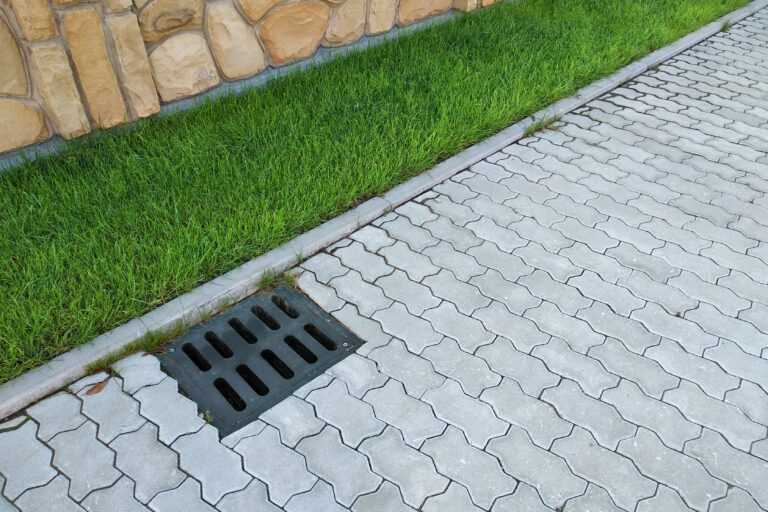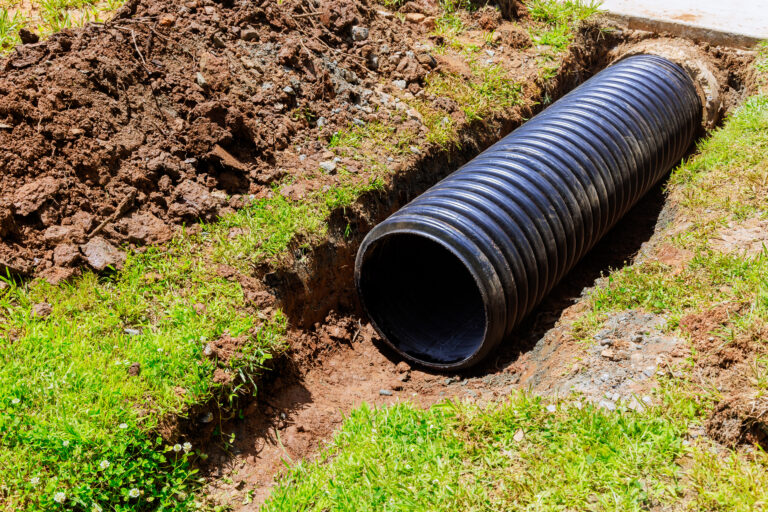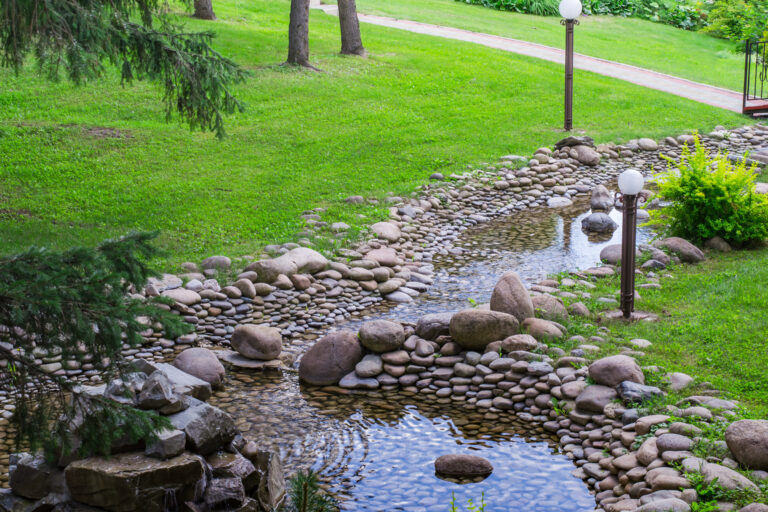Table of Contents
1. Regrade the Landscape to Protect the Foundation
Your yard’s slope is one of the most critical factors in drainage. Improper grading causes rainwater to pool near your foundation, eventually weakening it and causing cracks or leaks.
✅ What to do: Ensure the ground slopes away from your home by at least 6 inches over the first 10 feet. 👉 Learn how to do this step-by-step in our guide: How to Build Up Soil and Regrade Around Your Foundation
🏡 Foundation Focus: Poor grading is a major contributor to foundation settlement. Regrading helps stabilize your soil and keeps excess water from building hydrostatic pressure against basement walls.
♻️ Eco-Tip: Use recycled topsoil or compost-enhanced soil to rebuild the grade—good for plants and the environment.

2. French Drains for Subsurface Drainage
French drains are a classic and effective method to capture and divert water away from saturated areas or the foundation.
✅ Where it works best: Water pooling in low spots, near retaining walls, or alongside the home.
🛠️ How it works: Water enters a gravel-filled trench, flows into a perforated pipe, and is diverted away from your home. Not sure whether to dig by hand or bring in machinery? Here’s a breakdown: What’s Better: Hand Digging or Mechanical Excavation?
🌿 Eco-Benefit: Use landscape fabric made from recycled plastics beneath the gravel to prevent weed growth and encourage sustainable water flow.
3. Extend or Bury Downspouts
Downspouts that discharge too close to your foundation are a common culprit behind wet basements and crawlspaces.
✅ Simple fix: Add extensions (at least 4–6 feet long) or underground drainage pipes that empty into a dry well or rain garden.
🏚️ Foundation Risk: When water isn’t carried far enough away, it saturates the soil near footings and causes differential movement.
💧 Green Idea: Connect downspouts to rain barrels for harvesting water and reusing it in your garden.

4. Create a Decorative Dry Creek Bed
Dry creek beds do double duty: they manage runoff and enhance your landscape.
✅ What it is: A shallow trench lined with rocks and boulders, designed to guide stormwater naturally away from your home.
🌦️ When to use it: Ideal for hilly or sloped yards with visible surface runoff.
♻️ Sustainability Tip: Source reclaimed stones and rocks from old construction sites or recycling centers to keep materials out of landfills.
5. Rain Gardens for Natural Filtration
A rain garden is a shallow, planted depression designed to absorb and filter stormwater.
✅ Why it works: Deep-rooted native plants slow down runoff, absorb moisture, and filter pollutants before they reach storm drains.
🌼 Foundation Benefit: By soaking up surface water, rain gardens reduce erosion and standing water near your home’s base.
♻️ Eco Bonus: Choose native, drought-tolerant plants to conserve water and support pollinators like bees and butterflies.

6. Install Permeable Surfaces
Hard, impervious surfaces like concrete or asphalt trap water and create runoff issues. Replacing these with permeable alternatives helps with absorption.
✅ Where to install: Driveways, walkways, patios, or garden paths.
🌍 Eco Upgrade: Use permeable pavers made from recycled rubber or concrete aggregate to reduce landfill waste.
💡 Bonus: Gravel and mulch areas can double as passive infiltration zones during heavy rain.
7. Sump Pump Installation for High-Risk Areas
Sump pumps are essential if you live in a flood-prone area or have a basement that collects water.
✅ How it works: A sump pump collects water from a pit and pumps it safely away from your home.
🔧 Smart Add-On: Install a battery backup to protect your home during storms and power outages.
💚 Green Tip: Connect your sump pump’s discharge line to a rain garden or natural drainage path to recycle water and reduce runoff volume.
8. Maintain Gutters and Roof Drainage
Clogged or damaged gutters lead to roof runoff that spills over and soaks the foundation perimeter.
✅ Checklist:
Clean gutters at least twice a year
Check for sagging or leaks
Make sure downspouts are properly connected
🧹 Preventative Maintenance: Gutter overflow can wash away soil and lead to costly foundation erosion.
♻️ Recycling Insight: Old gutter material can often be recycled (especially aluminum), reducing construction waste during upgrades.



